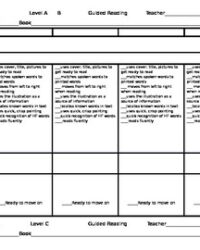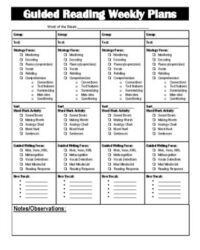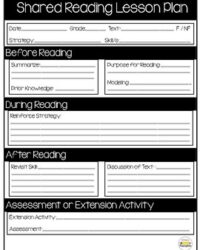Literature circles offer a wonderfully dynamic approach to teaching reading and fostering a love for books within the classroom. Imagine your students taking ownership of their learning, delving into discussions, and truly engaging with text in a collaborative environment. It’s a powerful method that moves beyond traditional whole-class instruction, allowing for differentiated learning and deeper comprehension. However, to harness this power effectively, you need a solid framework.
That’s where a well-crafted literature circle lesson plan template becomes an invaluable tool. It provides the necessary structure and guidance without stifling the organic, student-led nature of the circles. Think of it as your navigational chart for a successful literary journey, ensuring that every student is engaged, every discussion is purposeful, and every learning objective is met. It transforms the potentially chaotic into a beautifully organized learning experience.
The Anatomy of Engaging Literature Circles
At its heart, an engaging literature circle thrives on student autonomy and focused collaboration. It’s not just about reading a book; it’s about interacting with the text, with peers, and with diverse perspectives. For these circles to truly flourish, they need clear expectations and roles, ensuring that every participant contributes meaningfully. An effective circle encourages critical thinking, active listening, and the articulation of ideas in a supportive group setting, making the learning process both educational and enjoyable for everyone involved.
A typical literature circle session usually kicks off with individual preparation, where students complete assigned readings and prepare their thoughts based on their specific roles. This pre-discussion work is crucial for setting the stage. Following this, the small groups meet to discuss their insights, share their findings, and pose questions to one another. The teacher’s role transitions from lecturer to facilitator, observing, guiding, and stepping in only when necessary to prompt deeper thinking or redirect off-topic conversations. Post-discussion activities might include journaling, sharing insights with the larger class, or engaging in creative responses to the text.
Student Roles in Literature Circles
One of the most distinctive features of literature circles is the assignment of specific roles to students, which rotate over time. These roles ensure that all facets of literary analysis are covered and that every student has a distinct purpose within the group. For example, a Discussion Director might prepare questions to guide the conversation, while a Literary Luminary points out significant passages. A Connector finds links between the text and the real world, other books, or personal experiences. The Summarizer provides a brief overview of the reading, and the Vocabulary Enricher identifies and clarifies challenging words. These roles promote accountability and a comprehensive understanding of the text, moving beyond simple plot recall to deeper analytical engagement.
Setting Up the Environment
Creating the right environment is just as important as defining roles. This involves careful grouping of students, often based on reading level or interest in a particular book, to foster productive discussions. Providing clear guidelines for group work, including active listening and respectful disagreement, is paramount. Additionally, having a diverse selection of books that cater to various reading levels and interests empowers students to make choices, which in turn boosts their motivation and engagement. When students feel a sense of ownership over their reading material, the learning experience becomes significantly more impactful.
Customizing Your Classroom with a Robust Template
Embracing a literature circle lesson plan template can dramatically simplify your planning process while ensuring a consistent and effective learning experience. Rather than starting from scratch each time, a template provides a clear framework, allowing you to focus more on the nuances of student engagement and less on administrative setup. It helps you articulate learning objectives, define assessment strategies, and outline the progression of activities, all in one organized document. This structured approach saves valuable time and ensures that every literature circle session is purposeful and aligned with curriculum goals.
A truly robust literature circle lesson plan template should include several key components designed to guide both the teacher and the students through the process. It should outline the specific learning objectives for the unit, list necessary materials (books, role sheets, discussion prompts), and detail the procedural steps from pre-reading activities to post-discussion reflections. Furthermore, incorporating sections for differentiated instruction and assessment strategies ensures that the template is adaptable to various student needs and provides avenues for evaluating comprehension beyond traditional quizzes. This comprehensive approach ensures that all aspects of the learning journey are considered and planned for effectively.
The beauty of using a pre-designed template is its inherent flexibility. While it provides a solid foundation, it’s not meant to be a rigid set of rules. Teachers can easily adapt a literature circle lesson plan template to suit different grade levels, specific literary texts, or unique classroom dynamics. You can modify the roles, adjust the duration of sessions, or integrate technology tools to enhance discussions. This adaptability means that whether you are introducing literature circles for the first time or refining an existing program, the template can be molded to fit your specific pedagogical vision, ensuring a fresh and engaging experience every time.
- Clearly defined learning objectives
- List of required reading materials and supplementary resources
- Detailed schedule of activities for each session
- Descriptions of student roles and their responsibilities
- Guidelines for group formation and norms
- Assessment criteria and methods (e.g., rubrics, journals)
- Differentiation strategies for diverse learners
- Reflection prompts for students and teachers
Implementing literature circles can transform your classroom into a vibrant hub of literary exploration and critical thinking. By empowering students to take charge of their learning and engage in meaningful discussions, you’re not just teaching them to read; you’re cultivating lifelong readers and articulate communicators. This student-centered approach fosters a deeper connection to literature and builds essential collaborative skills that extend far beyond the classroom walls.
Embrace the organizational power of structured planning to unlock the full potential of these dynamic learning groups. With a clear framework to guide your preparation, you can dedicate more energy to facilitating rich discussions and observing the remarkable growth of your students as they navigate complex texts and articulate their insights. It’s about creating a supportive and intellectually stimulating environment where every voice is heard and every story comes to life.


